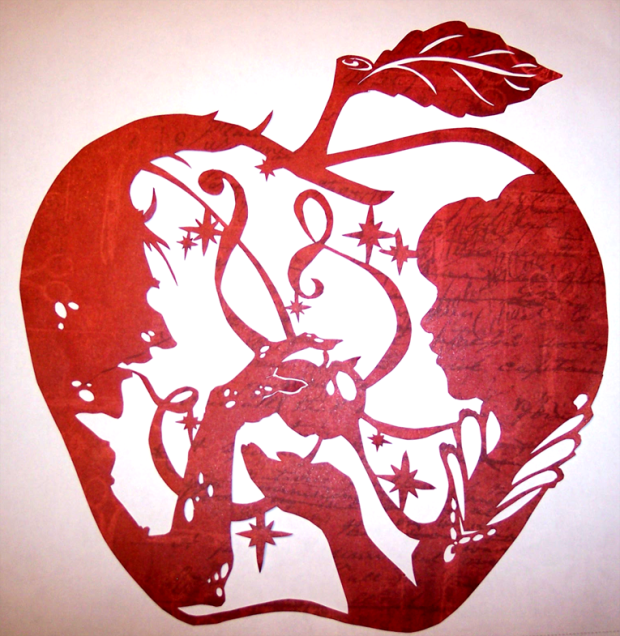The Art of Snow White – The Poisoned Apple
By Derek Newman-Stille
Snow White was originally published by the Brothers Grimm in 1812 and has been revisited in retellings and explorations since that time. It’s central features are the magic mirror, the poisoned apple, the glass coffin, and the heart. It is a tale of vanity, ageing, and revenge.
Ever since the Disney film Snow White and the Seven Dwarfs (1937), much of the imagery around Snow White has been influenced by the film.
Rebenke – Snow White Burton

Rebenke’s Snow White is dressed in the Disney Snow white colours with a tall white collar and blue, red, and yellow colours, yet each of these colours is shaded, the colours darkened.
The Evil Queen is portrayed in her disguise as an elderly woman, and she is portrayed with her mouth open in a cackle showing jagged, yellowed teeth. Her jaw is unhinged, portraying a predatory quality to her. The focus on her mouth centres the idea of consumption in this narrative, exploring the image of the apple as an object of hunger and desire. The predatory quality of the Evil Queen is highlighted by her long, beak-like nose and posture that mimics that of a vulture.
The image centres the apple, portraying it as the only red in the image that isn’t muted. The apple is even surrounded with a rosy red glow and sparkles. Rebenke brings attention to the apple as the moment of encounter between Snow White and the Evil Queen, the point of connection between the two women.
Rebenke casts the background entirely in grey tones with few features. There are some branches in the background, but limited to the edges. This is a stark change from many of the Disneyfied Snow White images, which tend to portray the encounter between Snow White and the Evil Queen in the depths of the woods.
Rebenke combines the saccharine imagery of Disney with the darker image of Tim Burton’s sketches in a subversion of that saccharine quality. Rebenke’s snow shite is portrayed with typical Burtonesque features – dark circles around the eyes, a pale face, an extended, thin neck, long thin arms and pointed fingers. The paleness of Snow White provides a point of contact between the Disney image and Burtonesque images. Her pale skin is turned macabre.
Rebenke is an artist on DeviantArt who gives his name as “Jonas” and whose gallery can be found at http://rebenke.deviantart.com/
Mallory Thompson (Illeander) – Paper Tales: The Poison Apple

Mallory Thompson (Illeander)’s Snow White centres the image of the apple, using the apple itself as a framing technique. The image focuses on the upper bodies of the Evil Queen and Snow White, bringing attention to their faces in the encounter. This is a story of persuasion The Evil Queen’s voice is portrayed as flowing out in a physical way, wrapping around the apple itself and surrounded by stars. This is a voice of enchantment and persuasion.
The power of text in this image is further shaped by the use of papercraft for the tale, exploring the role of paper and voice. This is further explored by the text written across Snow White’s body.
The Evil Queen holds the apple above Snow White’s hand, using the gesture of offering to indicate the exchange between them. She holds the apple between hand and mouth, playing with the intermingling of offering and desire in this narrative. She taunts Snow with the apple near her mouth.
The Evil Queen’s body is marked by holes and pockmarks, conveying ideas of age through holes. This image is mirrored in the shine of the apple, also indicated through holes.
Mallory Thompson creates her art under the name Illeander on DeviantArt (http://illeander.deviantart.com/).
Prudence Staite

Prudence Staite creates her entire image of Snow White from apples, building her body from the fruit that poisoned her. Staite takes advantage of the whiteness of the apple’s flesh to create Snow White’s pale skin.
Staite uses the chunks of apples to mimic the quality of stained glass, fracturing Snow White’s image and constructing it of parts. Staite uses whole apples as a framing technique, showcasing a variety of apples and the complexity of colours of the species.
The power of Staite’s Snow White image is its impermanence. This image is only temporary and it is one that will rot, playing with the reversal of Snow White herself who was captured in a state of perpetual preservation, free from ageing and rot even in death.
Although clearly influenced by Disney’s princess, Staite plays with the colouring of Snow White’s dress to focus instead on the diversity of apple colours.
Rather than using one central apple in Snow’s hand, Staite uses a fractured set of apple pieces to construct the apple, bringing in the stained glass effect that the fractured apples provide for the rest of the image.
Prudence Staite’s runs the website Food is Art at http://www.foodisart.co.uk/FOOD_IS_ART/HOME.html . She refers to works like the Snow White image above as Food Paintings, which she constructs out of materials like pasta, spices, chocolate, tea, nuts, cereal, fruit, vegetables, and cakes. She calls each of her paintings as “an edible work of art” and brings attention to the power of her work to stimulate the senses.